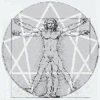“This same process of the harmonious development of man can be examined from the point of view of the law of octaves. The law of octaves gives another system of symbols. In the sense of the law of octaves every completed process is a transition of the note do through a series of successive tones to the do of the next octave. The seven fundamental tones of the octave express the law of seven. The addition to it of the do of the next octave, that is to say, the crowning of the process, gives the eighth step. The seven fundamental tones together with the two ‘intervals’ and ‘additional shocks’ give nine steps. By incorporating in it the do of the next octave we have ten steps. The last, the tenth, step is the end of the preceding and the beginning of the next cycle. In this way the law of octaves and the process of development it expresses, include the numbers 1 to 10. At this point we come to what may be termed the SYMBOLISM of numbers. The SYMBOLISM of numbers cannot be understood without the law of octaves or without a clear conception of how octaves are expressed in the decimal system and vice versa. Fragments: Fourteen
“In Western systems of occultism there is a method known by the name of ‘theosophical addition,’ that is, the definition of numbers consisting of two or more digits by the sum of those digits. To people who do not understand the SYMBOLISM of numbers this method of synthesizing numbers seems to be absolutely arbitrary and to lead nowhere. But for a man who understands the unity of everything existing and who has the key to this unity the method of theosophical addition has a profound meaning, for it resolves all diversity into the fundamental laws which govern it and which are expressed in the numbers 1 to 10. Fragments: Fourteen
“As was mentioned earlier, in symbology, as represented, numbers are connected with definite geometrical figures, and are mutually complementary one to another. In the Cabala a symbology of letters is also used and in combination with the symbology of letters a symbology of words. A combination of the four methods of SYMBOLISM by numbers, geometrical figures, letters, and words, gives a complicated but more perfect method. Fragments: Fourteen
“And in this sense it is possible to speak of the SYMBOLISM of speech although this SYMBOLISM is not understood by everyone. To understand the inner meaning of what is said is possible only on a certain level of development and when accompanied by the corresponding efforts and state of the listener. But on hearing things which are new for him, instead of making efforts to understand them, a man begins to dispute them, or refute them, maintaining against them an opinion which he considers to be right and which as a rule has no relation whatever to them. In this way he loses all chance of acquiring anything new. To be able to understand speech when it becomes symbolical it is essential to have learned before and to know already how to listen. Any attempt to understand literally, where speech deals with objective knowledge and with the union of diversity and unity, is doomed to failure beforehand and leads in most cases to further delusions. Fragments: Fourteen
“Therefore, because of the tendency referred to in our thinking, it often happens that exact knowledge concerning details, communicated to a man before he has acquired an understanding of the essential nature of a thing, makes it difficult for him to understand this essential nature. This does not mean that exact definitions do not exist on the way of true knowledge, on the contrary, only there do they exist; but they differ very greatly from what we usually think them to be. And if anyone supposes that he can go along the way of self-knowledge guided by an exact knowledge of all details, and if he expects to have such knowledge without first having given himself the trouble to assimilate the indications he has received concerning his own work, then he should first of all understand that he will not attain knowledge until he makes the necessary efforts and that only of himself and only by his own efforts can he attain what he seeks. No one can ever give him what he did not possess before; no one can do for him the work he should do for himself. All that another can do for him is to give him the impetus to work and from this point of view SYMBOLISM, properly perceived, plays the part of an impetus of this kind for our knowledge. Fragments: Fourteen

